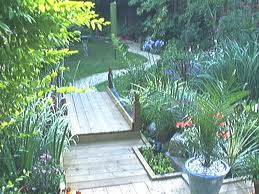





Decking is a convenient means of hiding a pool edge or providing a landing platform. When built well, it can be most attractive and very functional. With a large pool, it can be extended over the water to provide a place to relax among the aquatic life.
 When decking extends over the water, it must be arranged tastefully and not detract from the overall beauty of the water garden. For most garden pools, it need not project much beyond the edge, its supports being set into the surrounding ground rather than the pool itself. However you decide to construct it, decking will be most effective if it is just above the surface of the water. In such circumstances, its reflection in the water will be less obvious and will not dominate the scene. At the same time, the appearance of water running back below it will produce a much more attractive effect than if dry land is revealed.
When decking extends over the water, it must be arranged tastefully and not detract from the overall beauty of the water garden. For most garden pools, it need not project much beyond the edge, its supports being set into the surrounding ground rather than the pool itself. However you decide to construct it, decking will be most effective if it is just above the surface of the water. In such circumstances, its reflection in the water will be less obvious and will not dominate the scene. At the same time, the appearance of water running back below it will produce a much more attractive effect than if dry land is revealed.
For most water garden features, garden decking is likely to run along the edge of the pool in a fairly narrow strip, rather like an expanded causeway, but much closer to the water. It can be used more imaginatively with formal pools and can be integrated much more effectively as an element of the formal landscape. All manner of shapes can be devised, including octagons, rectangles, triangles and squares. Hardwood is the best material to use, not only being very tough and weather resistant, but also mellowing to a pleasant silvery brown. Narrow boards, about 10cm (4in) wide, will be ideal.
As part of the garden decking will be over dry land, it will be possible to incorporate one or two neat openings to allow plants to grow through. This will help link it with the surrounding landscape. Use hardy plants to ensure their survival.
If the garden decking is to extend into the pool, proper foundations should be provided. The same technique described for bridges should be employed. When timber uprights are used, they should be at least 10cm (4in) square and can either be set in large blocks of concrete, or dropped into pipes set into concrete in the same manner as for a causeway. Strong wooden posts should also be used to support the landward side of the decking. Whether timber uprights or piers are used, they must all be vertical and their tops level. The horizontal deck bearers can then be bolted to them, and the boards screwed to the bearers. The boards should be laid with gaps of about 1cm (3/8in) between them, which will not only look attractive, hut also allow surface water to drain off.
Decking that extends out into the water often ends with a feature, such as a circular or octagonal platform that can he used for sitting out. It is not desirable to install extensive safety rails along the edges of decking, for this will detract from the beauty of the feature. However, if you have young children, you will have no option, even if the decking is constructed in shallow water. When the children are old enough to understand the dangers of the water, you can remove the rails.
Where children will not be involved, the only concession to safety need be a low kick-board, which can be accommodated without causing any visual distraction. This will be particularly useful if a wheelchair is likely to be taken on to the garden decking. An upright, which may he an extension of one of the posts at the landward end of the decking, should also be provided as a hand hold for the less agile. If a small boat is part of the watery scene, the upright can serve as a mooring post.
Copyright © www.100flowers.win Botanic Garden All Rights Reserved